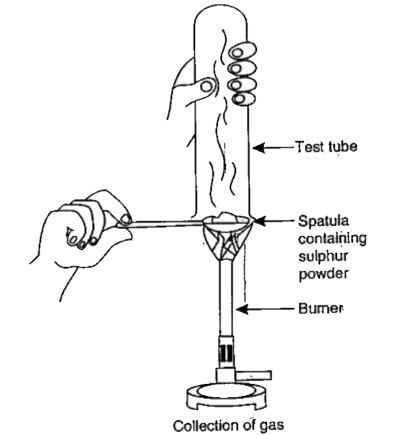Prateek took a piece of burning charcoal and collected the gas evolved in a test tube.
(a) How will he find the nature of the gas?
(b) Write down word equations of all the reactions taking place in this process?
Step-by-Step Solution:
1. Identify the Gas: Prateek collected the gas evolved from burning charcoal, which is primarily composed of carbon. When carbon burns in the presence of oxygen, it produces carbon dioxide (CO₂).
2. Confirmation Test: To confirm the nature of the gas, Prateek can perform a simple test using limewater (calcium hydroxide solution).
3. Conduct the Test: He should pass the collected gas (assumed to be CO₂) through a test tube containing limewater.
4. Observe the Reaction: If the gas is indeed carbon dioxide, it will react with limewater to form calcium carbonate, which is insoluble in water.
5. Result of the Test: The limewater will turn milky due to the formation of calcium carbonate, confirming that the gas evolved is carbon dioxide.
(b) Write down word equations of all the reactions taking place in this process.
1. Combustion of Carbon:
- The reaction of charcoal (carbon) with oxygen can be written as:
- Word Equation: Carbon + Oxygen → Carbon Dioxide
- (C + O₂ → CO₂)
2. Reaction with Limewater:
- The reaction of carbon dioxide with limewater can be written as:
- Word Equation: Carbon Dioxide + Limewater → Calcium Carbonate + Water
- (CO₂ + Ca(OH)₂ → CaCO₃ + H₂O)
Final Summary:
- The nature of the gas can be confirmed by passing it through limewater, which will turn milky if the gas is carbon dioxide. The reactions involved are the combustion of carbon to form carbon dioxide and the reaction of carbon dioxide with limewater to form calcium carbonate.
---
- The reaction of charcoal (carbon) with oxygen can be written as:
- Word Equation: Carbon + Oxygen → Carbon Dioxide
- (C + O₂ → CO₂)
- The reaction of carbon dioxide with limewater can be written as:
- Word Equation: Carbon Dioxide + Limewater → Calcium Carbonate + Water
- (CO₂ + Ca(OH)₂ → CaCO₃ + H₂O)
- The nature of the gas can be confirmed by passing it through limewater, which will turn milky if the gas is carbon dioxide. The reactions involved are the combustion of carbon to form carbon dioxide and the reaction of carbon dioxide with limewater to form calcium carbonate.
Topper's Solved these Questions
- METALS AND NON METALSBOOK - S CHAND IIT JEE FOUNDATIONCHAPTER - METALS AND NON METALSEXERCISE - QUESTION BANK-15
141 Videos
- HYDROGENBOOK - S CHAND IIT JEE FOUNDATIONCHAPTER - HYDROGENEXERCISE - SELF ASSESSMENT SHEET
28 Videos
- SYNTHETIC FIBRES AND PLASTICSBOOK - S CHAND IIT JEE FOUNDATIONCHAPTER - SYNTHETIC FIBRES AND PLASTICSEXERCISE - Self Assessment Sheet - 14
29 Videos
Similar Questions
Prateek took a piece of burning charcoal and collected the gas evolved in a test tube.
(a) How will he find the nature of the gas?
(b) Write down word equations of all the reactions taking place in this process?
View SolutionSaloni took a piece of burning charcoal and collected the gas evolved in a test tube.
How will she find the nature of the gas?
View SolutionSaloni took a piece of burning charcoal and collected the gas evoled in test tube.
How will she find the nature of the gas?
View SolutionPrateek took a piece of burning charcoal and collected the gas evolved in a test tube.
(a) How will he find the nature of the gas?
(b) Write down word equations of all the reactions taking place in this process?
View SolutionSaloni took a piece of burning charcoal and collected the gas evoled in test tube.
Write down word equations of all the reactions taking place in the process.
View SolutionSameer took sulphur powder on a spatula and heated it. He collected the gas evolved by inverting a test tube over it as shown in the figure.

Write a balanced chemical equation for the reaction taking place.
View SolutionPiyush took sulphur powder on a spatula and heated it. He collected the gas evolved by inverting a test tube over the burning sulphur.
(b) Write a balanced chemical equation for the reaction taking place.
View SolutionSameer took sulphur powder on a spatula and heated it. He collected the gas evolved by inverting a test tube over it as shown in the figure.

What will be the action of gas on dry litmus paper?
View SolutionSameer took sulphur powder on a spatula and heated it. He collected the gas evolved by inverting a test tube over it as shown in the figure.

What will be the action of gas on moist litmus paper?
View SolutionPratyush took sulphur powder on a spatula and heated it. He collected the gas evolved by inverting a test tube over it, as shown in figure below.

(a) What will be the action of gas on
(i) dry litmus paper?
(ii) moist litmus paper?
(b) Write a balanced chemical equation for the reaction taking place.
View Solution
